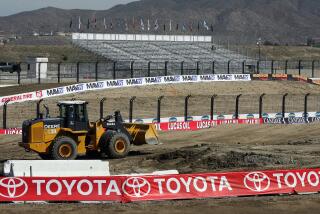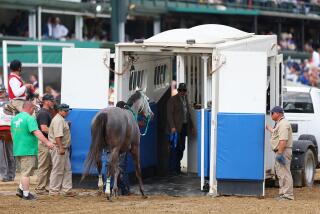Speed blamed for high death rates for ‘supersport’ cycles
When it comes to motorcycles, speed kills.
At least that was the conclusion of an insurance industry study released Tuesday that found that motorcyclists were three times more likely to die when riding a high-performance racing bike than a hulking Harley-Davidson.
So-called supersport motorcycles have become increasingly popular in recent years, especially among young riders looking for an extremely fast, lightweight bike.
They have starred in such speed-culture movies as “The Fast and the Furious” and are often referred to as rice rockets, a nod to the popularity of Japanese-made models, such as the Kawasaki Ninja ZX-6R, that have top speeds in excess of 150 mph.
This high performance comes at a cost, according to the Insurance Institute for Highway Safety, the insurer-funded research body that conducted the study on motorcycle safety.
“Supersport motorcycles are indeed nimble and quick, but they can be deadly,” said Anne McCartt, the institute’s senior vice president for research. “Motorcyclists presumably buy supersports and sport bikes because they want to go fast, and manufacturers are happy to oblige.”
The institute’s findings, which were challenged by the motorcycle industry, come at a time when motorcycle ridership and fatalities are on the rise.
It’s not clear what effect, if any, the study will have on insurance rates. For example, a spokesman for State Farm said the insurer based its premiums on its own loss experience rather than on outside studies.
In 2005, supersport motorcycles had a death rate of 22.5 per 10,000 registered bikes, according to the institute. That compared with 6.5 deaths per 10,000 touring motorcycles, a class that includes the Harley-Davidson Ultra Classic Electra Glide, and 7.5 per 10,000 motorcycles overall.
Supersport bikes are designed as racing bikes and are then modified for highway use -- hence the emphasis on speed.
“Supersport motorcycles have such elevated crash death rates and insurance losses because many people ride them as if they were on a racetrack,” McCartt said.
In 2005, speed was cited as a factor in 57% of supersport riders’ fatal crashes, according to the institute. That compared with 22% of fatalities involving touring bikes.
But the Irvine-based Motorcycle Industry Council, which represents manufacturers, cited a 1981 study that found that “most motorcycle crashes occur at relatively low speeds.” The median pre-crash speed was around 30 mph, according to that study.
“The choice to exceed the posted speed limit remains with the rider,” the industry council said in a statement. “Placing limits on a vehicle’s maximum speed capability is not likely to contribute to saving lives.”
The Kawasaki Ninja and the Harley Electra Glide provide a vivid example of how motorcycles can differ in power and weight. According to institute figures, the 2006 Ninja generates 111 horsepower and weighs 404 pounds. The Harley produces 65 horsepower and weighs in at 788 pounds.
The smallest supersports typically have 600-cubic-centimeter engines. The biggest models top 1,200 or even 1,400 cubic centimeters and can reach speeds approaching 200 mph. Riders say the Kawasaki ZX-10R can hit 110 mph in first gear.
“If you don’t respect a bike like that, you’re going to get hurt,” said 40-year-old Harout Moussa of Monrovia, who works as a motorcycle messenger and has a fondness for supersports.
“You have to go within your limits. You can’t just open it up and think you own the road.”
Riders also contend that cars manned by inattentive or aggressive drivers pose a bigger threat to motorcyclists than fast bikes.
The American Motorcyclist Assn., which represents motorcycle owners, declined to comment on the study. David Thom, a Los Angeles motorcycle safety expert who has testified before federal regulators, called the institute’s report “no surprise.”
“They’ve had an anti-motorcycle agenda forever,” he said.
Although supersports have by far the highest death rate among motorcycles, according to the institute, the fatality rate for touring bikes saw a rise from 5.3 per 10,000 in 2000 to 6.5 in 2005.
The increase in fatality rates for a class of bike associated more with older riders shows that inexperience comes into play at both ends of the age spectrum, said Jim Sibley, a longtime rider.
“More and more baby boomers are realizing their wishes and buying motorcycles, especially the big cruisers, yet have no real experience on them,” he said. “The results of their inexperience, especially as their reflexes slow, are more crashes and deaths.”
The institute found that alcohol was a factor in 26% of fatal accidents involving touring bikes in 2005, compared with 19% of supersport fatalities.
Nationwide, motorcycle registrations climbed 51% from 2000 to 2005, according to the institute. Registrations of supersport bikes jumped 83% in that period.
In California last year, motorcycle registrations rose 7.4% over 2005, to 748,857. Passenger vehicle registrations rose 1.7% to 22.1 million during the same period.
Motorcycle fatalities in the U.S. have more than doubled in 10 years, reaching 4,810 in 2006 and accounting for 11% of highway deaths, according to the institute.
The overall motorcycle fatality rate is more than 7 times the 1-per-10,000 rate for passenger vehicles.
--






